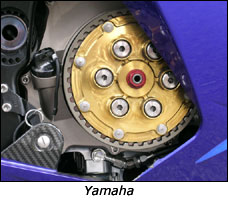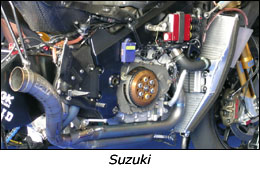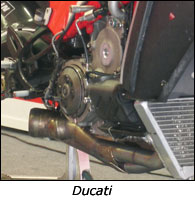|
From the start of MotoGP the four-strokes have been fitted with slipper clutches. As time has gone on designs have matured and there now seems a broad agreement on the correct way to do it.
With the old two strokes there was little engine braking, and no valve gear to be sensitive to over revving.
Bikes could arrive at corners real fast, the riders could change down late and there were no real problems with rear wheel lockup. With four stroke bikes it's all different though.
The battle is to get a racing motorcycle into a corner as fast as possible and as smoothly as possible, to do this anything that can disturb the delicate balance of grip and slide through the tyres has to be
eliminated. There are several problems, rear wheel hop when the bike is upright and with the brakes hard on, there are difficulties with rear suspension responses being affected by the pull on the chain when
the throttle is shut and there is the loss of valuable rear wheel grip as the rear wheel has to turn the engine over compression rather than providing side grip into the corner.
MotoGP riders are used to getting their bikes rolled into the corner with as much grip as possible as fast as humanly possible, having to deal with a rear brake that works when you shut the throttle, which is not
necessarily when you want it to, just isn't the quick way round.
The important point is that we are talking about helping the entry to fast corners here, and freeing the rider from having to worry about the effects of closing the throttle, in slow corners or into fast corners.
So why does everyone now seem to need a slipper clutch?
As racing big four strokes become more common, and as compression ratio's rise, it becomes more and more important to stop the rear wheel affecting the suspension. Your bikes rear wheel is attached by chain to the
gearbox, and through that to the clutch and crankshaft. As you increase cylinder compression the effect the engine has on the chain under deceleration is to pull at the lower run of the chain.
The angle of this pull, and the erratic nature of the way it is pulled, load's the rear suspension up and destroys the smooth connection between the tyre and the track you need for the grip that let's you really go fast. And if the guy next to you is quicker into the corner then you will lose.
The problems are many; how can you squeeze a new mechanism into a clutch and add as little weight (or more accurately as little rotational inertia) as possible? How can you limit wear yet still get all the benefits,
how much do you want to use the clutch manually and can you make its job easier? MotoGP has the benefit of being able to design brand new engines specifically for the purpose, the rest of us, well nearly all of us,
modify things and go racing.
Tickover levels, adjusting them on the move
For years the use of high tick over levels has been used to lower the level of engine braking 'felt' by the rear tyre. Static tickovers around 2500rpm are quite common. One difficulty is the way the front can
be 'pushed' in slower corners if the engine revs are too high, a very disconcerting feeling.
Another is the way that the ignition advance curve seems to slow the engines throttle response when its base throttle position is set too high.
During the first three years of MotoGP a lot of experimentation brought us the concept of the 'throttle kicker', this is a small servomotor that allows the engine management computer to increase tickover on demand.
Most bikes started their development at the Superbike stage, running a high (2000 rpm plus) tickover to get rid of the worst of the problem, the trouble with this is that at high speed you could probably do with a throttle position that would in calmer circumstances give a 4000 rpm tickover, at low speeds you need to be down somewhere near the equivalent of 1500 rpm to stop the front wheel being pushed in slower corners. These kickers are getting better but they definitely work better when they are used to back up the primary device, the slipper clutch.
Clutch Design; the many choices…
 Most slipper clutches use a simple ramp system to lift
the centre of the clutch up as engine braking increases, the distance the centre has to travel in order to push the pressure plate off and break the clutch pack
friction makes a difference to the clutch feel. Yamaha, Suzuki and Ducati all use coil spring clutches, we cannot see the Honda choice because of their turbine cooling air cover. Proton, Kawasaki and WCM use
diaphragm spring systems with metal plates, Aprilia use an AP based, Aprilia modified, carbon system. Most slipper clutches use a simple ramp system to lift
the centre of the clutch up as engine braking increases, the distance the centre has to travel in order to push the pressure plate off and break the clutch pack
friction makes a difference to the clutch feel. Yamaha, Suzuki and Ducati all use coil spring clutches, we cannot see the Honda choice because of their turbine cooling air cover. Proton, Kawasaki and WCM use
diaphragm spring systems with metal plates, Aprilia use an AP based, Aprilia modified, carbon system.

Both clutch weight and rotational inertia, if you have an additional mechanism in your clutch it is going to be heavier than the original, the factory MotoGP devices are built to very high standards of
weight saving and noticeably have a myriad of holes lightening the device where they can, where they have design their own clutch, they
have also noticeably tried to keep what weight there is near the centre of the hub, keeping weight near the centre that means they mostly favour the coil spring solution. The reasons seem to vary
from a reluctance to put extra weight near the circumference of the clutch to restrict the effect of rotational inertia to the desire to keep the riders clutch 'feel' the same.

Usual race design has a ramp mechanism under the area between each spring post. The angle of the ramp depends on manufacturer and 'rider feel'. Some slipper clutches use
simple ramps, some use ball bearings in the ramps; one design uses a ramp in the centre, on the engine side of the cases and then transfers the lift through a series of seals.
One of the issues to consider with the compromise that is slipper clutch design is the method of starting, with external dry clutches it is possible to lock the clutch manually for
starting, In MotoGP Ducati, Suzuki and WCM use this method. With wet clutches it is very difficult to lock the clutch so the game depends on the likely start system, for
Supersport Sigma assumes the electric start will be operational (its supposed to be under the rules!!) as our ramp design makes bump starting a bit difficult. Under
Superbike rules the starters can come off and most starting is via a bump or an external starter motor, on our Superbike clutches you can bump start the bike without a locking device.
Copyright Neil Spalding 2002- 2005
|